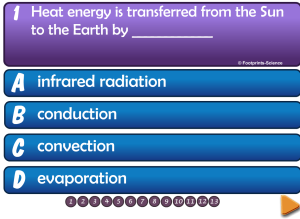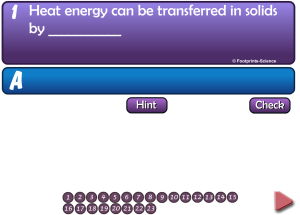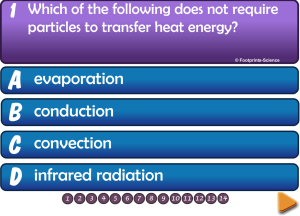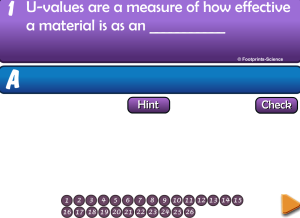P1.1 Transfer of heat energy
Energy can be transferred from one place to another by work or by heating processes.
This topic is divided into 8 sections:
1. Infrared radiation, including surfaces and radiation
2. Kinetic theory and states of matter
3. Conduction
4. Convection
5. Evaporation and condensation
6. Factors affecting energy transfer by heating
7. Specific heat capacities
8. Heating and insulating buildings
1. Infrared radiation, including surfaces and radiation
All objects emit and absorb infrared radiation.
The hotter an object is the more infrared radiation it radiates in a given time.
Heat energy is transferred from the Sun to the Earth by infrared radiation.
Dark, matt surfaces are good absorbers and good emitters of infrared radiation.
Light, shiny surfaces are poor absorbers and poor emitters of infrared radiation, but good reflectors of infrared radiation.
Quiz by Footprints science (click here)
2. Kinetic theory and states of matter
Kinetic theory is used to explain the different states of matter.
Students should demonstrate their understanding of the differences between the states by constructing simple diagrams.
All changes in state represent physical changes:
- Melting: converts solids into liquids.
- Freezing: converts liquids into solids.
- Boiling: converts liquids into gases at the boiling point of the substance.
- Evaporating: converts liquids into gases at temperatures below the boiling point of the substance.
- Condensing: converts a gas back into liquid by cooling.
The particles of solids, liquids and gases have different amounts of energy.
[Note to students: an understanding of specific latent heat is not required]
Quiz by Footprints science (click here)
3. Conduction (transfer of heat through solids)
Heat energy can be transferred in solids by conduction:
• heating one end of a solid causes the particles to vibrate more
• the neighbouring particles vibrate which causes particles nearby to vibrate and so on
• in this way heat energy is passed through the substance.
A solid that is good at transferring heat is known as a conductor (e.g. copper metal): metals are the best conductors because they contain free electrons that can travel through the metal and transfer the heat very quickly.
A solid that is not good at transferring heat is known as an insulator (e.g. plastic)
Candidates should understand in simple terms how the arrangement and movement of particles determine whether a material is a conductor or an insulator.
4. Convection (transfer of heat through liquids)
A fluid might be a liquid or a gas. Heating a fluid causes the particles to move apart, making it less dense and causing it to rise. Cold fluids replace the hot fluid that has risen and are then heated. This sets up a convection current.
5. Evaporation and condensation
• Evaporation occurs when liquid particles gain energy and become gas particles.
When sweat evaporates from your skin, heat energy is taken from the skin surface to give the liquid particles the energy they need to become gas particles. This process causes your skin surface to cool down. The entire process occurs at temperatures below the boiling point of the substance (i.e. sweat in this example).
• Condensation occurs when gas particles lose energy and become liquid particles.
• The factors that affect the rate of evaporation and condensation.
Candidates should be able to explain evaporation and the cooling effect this causes using the kinetic theory.
Candidates should be able to explain the design of devices in terms of energy transfer, for example, cooling fins.
Quiz by Footprints science (click here)
6. Factors affecting energy transfer by heating
The rate at which an object transfers energy by heating depends on:
■ surface area and volume ratio of the object
■ the material from which the object is made
■ the nature (type)of surface with in contact with the object.
If the object is in contact with a metal, the rate of heat transfer by conduction will be quicker but heat transfer by infrared radiation will be slower.
Candidates should be able to explain animal adaptations in terms of energy transfer, for example, relative ear size of animals in cold and warm climates.
The greater the temperature difference between an object and its surroundings, the faster the rate at which energy is transferred by heating.
Quiz by Footprints science (click here)
7. Specific heat capacities
The specific heat capacity of a substance is the amount of energy required to change the temperature of one kilogram of the substance by one degree Celsius.
E= m × c × Θ
E is energy transferred in joules, J
m is mass in kilograms, kg
Θ is temperature change in degrees Celsius, °C
c is specific heat capacity in J / kg °C
■ evaluate different materials according to their specific heat capacities. Examples include the use of water, which has a very high specific heat capacity, oil-filled radiators and electric storage heaters containing concrete or bricks.
8.Heating and insulating buildings
U-values measure how effective a material is as an insulator: the lower the U-value, the better the material is as an insulator.
Homes can be made warmer by installing: double glazing, loft insulation and cavity wall insulation.
Extra insulation will cost the homeowner but over time the homeowner will make savings on their energy bills. The time taken for the homeowner to recover the money spent on installing the different types of insulation is known as the payback time.
Solar panels may contain water that is heated by radiation from the Sun. This water may then be used to heat buildings or provide domestic hot water. (e.g. for washing up, baths etc.)
Quiz by Footprints science (click here)
■ evaluate the effectiveness of different types of material used for insulation, including U-values and economic factors including payback time.
Suggested practical work
Passing white light through a prism and detecting the infrared radiation with a thermometer.
Demonstration using balls in a tray to show the behaviour of particles in substances in different states
Measuring the cooling effect produced by evaporation: putting wet cotton wool over the bulb of a thermometer or temperature probe.
Plan and carry out an investigation into factors that affect the rate of cooling of a can of water, eg shape, volume, and colour of can.
Using Leslie’s cube to demonstrate the effect on radiation of altering the nature of the surface
Plan and carry out an investigation using immersion heaters in a metal block to measure specific heat capacity
investigating thermal conduction using rods of different materials.
Candidates should use their skills, knowledge and understanding to:
■ compare ways in which energy is transferred in and out of objects by heating and ways in which the rates of these transfers can be varied
■ evaluate the design of everyday appliances that transfer energy by heating, including economic considerations.
Examples include:
the design of a vacuum flask
how to reduce the energy transfer from a building
how humans and animals cope with low temperatures
radiators and heat sinks.




